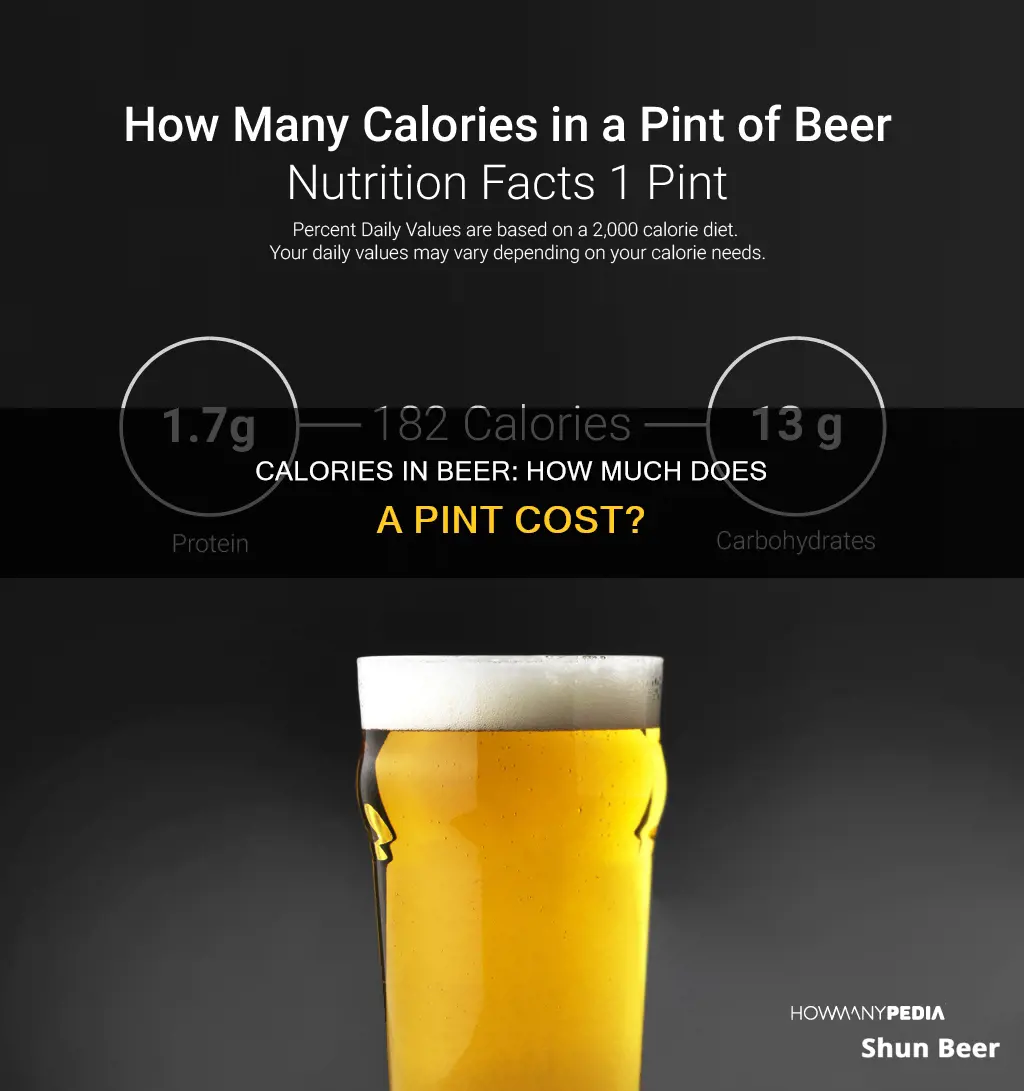
Beer is a popular alcoholic drink, but how many calories are in a pint? Alcohol is calorie-dense, and beer contains carbohydrates from unfermented grains, which are another source of calories. The calorie count in a pint of beer varies depending on the type and brand, but on average, a pint of beer contains around 180 to 250 calories. The strength of the beer also plays a role, with stronger beers tending to have more calories.
What You'll Learn

Beer calories depend on alcohol content, serving size, and type of beer
Beer is made from grains, which can be healthy, but it is not a health drink. Beer is high in calories, which come mostly from alcohol and, to a lesser extent, from carbohydrates. A gram of alcohol contains seven calories, almost as much as a gram of pure fat.
The number of calories in beer depends on its alcohol content. Beers with a higher alcohol content will have more calories than those with a lower alcohol content. For example, a 12-ounce beer that is 4% ABV has about 150 calories, while an average IPA with a higher alcohol content has 180 to 200 calories in 12 ounces.
The serving size also matters. A typical pint of beer contains around 215 calories, but this can range from 188 to 257 calories per pint. A 16 or 20-ounce draft pour can contain 200 to 250 calories.
The type of beer also affects its calorie content. Lagers tend to have fewer calories than ales, and ales tend to have fewer calories than stouts. However, there are exceptions. For example, some lagers may contain as many calories as a dark beer.
Light beers usually have fewer calories because they have fewer carbohydrates and more water. Low-calorie beers typically have a low ABV of 4.5% or less, while high-calorie beers usually have a high ABV of 6% or higher.
Understanding Beer Strength: 3.2% vs Regular
You may want to see also

Alcohol is highly calorific, with 7 calories per gram
Alcohol is highly calorific, with seven calories per gram. This calorific content is almost as high as a gram of fat, which contains nine calories per gram. Alcoholic drinks can be high in calories, and drinking can add 500 or more calories to your daily intake. Alcohol contains more calories per gram than carbohydrates, which have four calories per gram.
The calories in beer come from two sources: alcohol and carbohydrates. About 60% of beer calories come from alcohol, with the rest derived from residual carbohydrates that were not fully fermented during the brewing process. Different types of beer contain different quantities of carbohydrates; lagers, for example, tend to have fewer carbs than ales, which in turn have fewer than stouts. However, this is not always the case, and some lagers may contain as many calories as a dark beer.
The average pint of beer contains around 215 calories, but this varies depending on the brand and style. The calorie content of a pint ranges from 188 to 257 calories across the ten most popular beers in the UK. There is a clear correlation between a beer's strength and its calorie content. For instance, a pint of strong lager typically contains 235 calories, while a pint of small beer lager has only 125 calories.
The impact of drinking on weight gain is not limited to the calories in the alcohol itself. Drinking alcohol with a meal can cause you to consume more food, as it lowers your inhibitions and makes you less concerned about ordering extra food or drinks. Research also suggests that alcohol can alter your brain chemistry so that you receive increased rewards from food. Additionally, drinking alcohol delays the fat-burning process, as the body prioritises processing and eliminating alcohol due to its toxic nature.
Beer Nuts vs Deer: What's the Difference?
You may want to see also

Beer is also made up of residual carbohydrates
Lagers are more fully fermented than ales, and they also contain fewer residual carbohydrates. Lagers' total carbohydrate content ranges from 10 to 30 g/l, while ales range from 15 to 60 g/l. New brewing styles, such as fully attenuated low-carb beers, have less than 9 g/l of carbohydrates.
The calorie count in beer is influenced by both alcohol levels and sugar/carbohydrate content, with alcohol typically contributing more to the overall calorie count due to its higher calorie density. However, the sugar content of beer should not be overlooked, as it can significantly impact the calorie count and, ultimately, contribute to weight gain if consumed in excess.
The number of calories in a pint of beer varies depending on the brand and style, but on average, a typical pint contains around 215 calories. The strength of the beer is directly correlated with its calorie content, with stronger beers having higher calorie counts.
While beer can be high in calories, it is not inherently fattening. However, consuming more calories than you expend can lead to weight gain. Therefore, drinking beer in moderation and choosing lower-alcohol options can help maintain a balanced lifestyle.
Half-Pint Whiskey: How Many Beers Does It Equal?
You may want to see also

On average, a pint of beer contains 160-257 calories
Beer is a popular alcoholic beverage, but it's important to be aware of its calorie content, especially if you're mindful of your weight or aiming for a balanced lifestyle. On average, a pint of beer contains 160-257 calories, and this range can be influenced by various factors, which we'll explore in more detail.
Firstly, it's worth noting that the calorie content of beer depends on several factors, including the serving size, alcohol content, and type of beer. The alcohol content, measured as alcohol by volume (ABV), plays a significant role in determining the number of calories. A higher ABV indicates a stronger beer, which tends to have more calories. For example, a strong lager with a higher ABV will have more calories per pint than a mid-strength lager.
Additionally, the type of beer, such as lager, ale, or stout, also influences the calorie count. Lagers, for instance, generally have fewer calories than ales, which in turn have fewer calories than stouts. However, this isn't always the case, as some lagers may contain as many calories as darker beers. The colour and density of the beer don't always indicate the calorie content, as some lighter-coloured lagers can have more calories than darker beers.
Furthermore, the ingredients and brewing process can affect the calorie count. Beer is made by fermenting cereals, commonly malted barley, which produces alcohol. Alcohol is calorie-dense, containing approximately seven calories per gram, almost as much as pure fat. The carbohydrates left over from the brewing process also contribute to the calorie content. Different types of beer use varying ingredients and processes, resulting in different calorie counts.
While beer can be high in calories, it's important to remember that the occasional pint won't make you gain weight. However, regular consumption of more calories than you need can lead to weight gain over time. If you're concerned about calorie intake, there are lower-calorie beer options available, such as low-alcohol or non-alcoholic beers, which typically have fewer calories. Additionally, drinking in moderation, choosing lower-ABV beers, and avoiding rounds can help reduce your overall calorie intake.
In conclusion, while a pint of beer typically contains 160-257 calories, this range varies due to factors like alcohol content, beer type, and brewing processes. Being mindful of these factors and making informed choices can help you maintain a balanced and healthy lifestyle.
Beers and Rum: Pint Conversion and More
You may want to see also

Beer with lower alcohol content has fewer calories
Beer is a popular alcoholic beverage, but it's important to be mindful of its calorie content, especially if you're watching your weight. The calorie count in beer depends on various factors, including serving size, type of beer, and most importantly, its alcohol content.
Alcohol and carbohydrates are the two primary sources of calories in beer. According to the Homebrewer's Association, about 60% of the calories in beer come from alcohol, with the remaining coming from carbs. A gram of alcohol contains seven calories, almost as much as a gram of pure fat. Therefore, beers with lower alcohol content will generally have fewer calories.
When it comes to popular beer types, lagers tend to have fewer carbs and calories than ales, and ales typically have fewer than stouts. However, this is not always the case, as some lagers can have as many calories as dark beers. For example, Budweiser, a lager, has around 150 calories, while a stout, a darker beer, can have up to 210 calories.
If you're looking to cut down on beer calories, opting for lower alcohol beers is a good strategy. Beers with a lower ABV will have less alcohol in each serving, resulting in fewer calories. This allows you to enjoy a few drinks without worrying as much about the impact on your weight. Additionally, trying lower-calorie beers, such as Skinny Lager or Lean Brew IPA, can be a good alternative. These beers have significantly fewer calories and carbohydrates than regular lagers while still delivering a satisfying taste.
In conclusion, while beer can be high in calories, choosing beers with lower alcohol content is an effective way to reduce your calorie intake. This, combined with drinking in moderation and maintaining a balanced lifestyle, can help you manage your weight while still enjoying the occasional pint.
Exploring the Diverse Michelob Ultra Beer Family
You may want to see also
Frequently asked questions
On average, a pint of beer contains around 215 calories. However, this can vary depending on the type of beer and its alcohol content. The number of calories in a pint of beer ranges from 160 to 257 calories.
The calories in beer come from two sources: alcohol and carbohydrates. Alcohol has a high number of calories per gram (7 calories per gram), and it accounts for about 60% of the calories in beer. The remaining calories come from residual carbohydrates that weren't fully fermented during the brewing process.
If you're trying to cut down on beer calories, there are a few things you can do:
- Drink lower-alcohol beers. Beers with a lower ABV will have fewer calories.
- Avoid drinking in rounds. This can help you consume fewer calories and drink at your own pace.
- Drink less regularly. Simply reducing the frequency of your drinking can help cut down on beer calories.







